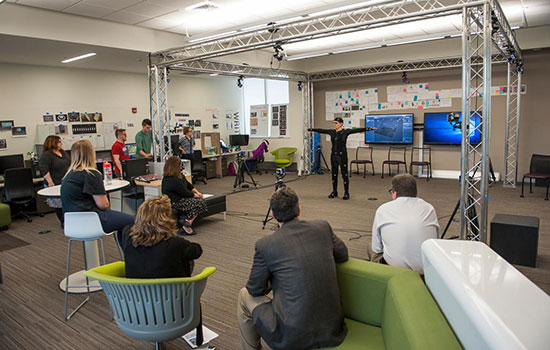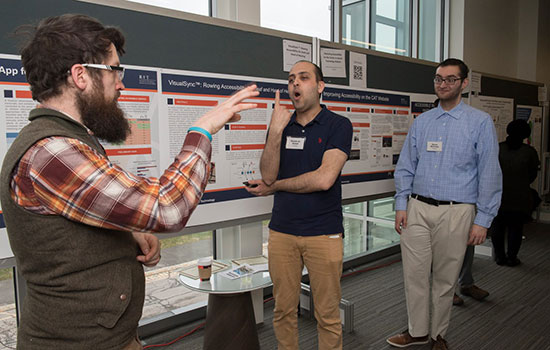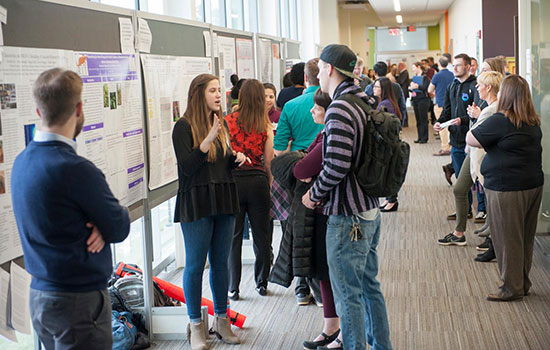NTID hosts Student Research Fair
Annual event showcases student research by deaf and hard-of-hearing students on health science, access technology, communication studies and more
Mark Benjamin
RIT/NTID student Joan Bempong showcased her research during the third annual NTID Student Research Fair on April 13.
Joan Bempong, a fifth-year BS/MS computer engineering student from Irving, Texas, believes that deaf women who use American Sign Language exhibit disparities in health literacy when compared to hearing women. She says limited health literacy may be caused by inaccessibility of mainstream information and healthcare services, as well as family communication difficulties. As a result, ineffective dissemination of health information also may have a significant impact upon deaf women’s mental and physical health. She hopes that her research will help develop a comprehensive framework for understanding how such health disparities occur and what steps can be taken to improve their quality of life.
Abraham Glasser, a third-year computer science student from Rochester, N.Y., and Emily Lederman, a second-year computer science student from Morgantown, W.V., are using mathematical equations to determine worst-case scenarios for monitoring electric power networks. They hope one day their research will save power companies and consumers a lot of money.
On April 13, Bempong, Glasser and Lederman joined 61 other deaf and hard-of-hearing student researchers at the National Technical Institute for the Deaf’s Student Research Fair in Rosica Hall. The event gives undergraduate and graduate students, in partnership with faculty mentors, the opportunity to present posters or give demonstrations on topics related to health science, communication studies, access technology and environmental research, among others.
Todd Pagano, associate dean for teaching and scholarship excellence and founding director of NTID’s Laboratory Science Technology program, is among the coordinators of the research fair. Pagano said the research fair is unique because of the training that is offered to students ahead of time on writing and editing abstracts, designing research posters and presenting research to audiences.
“The projects we’re seeing are very sophisticated and diverse with a good mix of high-level science, math, healthcare and access technology research,” said Pagano. “We send many of our students to professional conferences to present their work, but the pinnacle of the experience for students often is having their research published. And a lot of what is seen here at the research fair has already been published.”
Musab Al-Smadi, a fourth-year software engineering student from Jordan, also presented his research. He is working on an inclusive mobile app using Near Field Communication that will enable deaf and hard-of-hearing museumgoers to fully explore their surroundings without facing barriers having to do with obtaining information about exhibits. For example, according to Al-Smadi, many museums offer visitors paper transcripts with exhibit descriptions. However, using transcripts can be inconvenient for patrons with varying levels of vision ability, or frustrating for those for whom English is a second language. The new app can be used on Android and iOS platforms and includes a keypad where users can type in the ID number of the exhibit to get the information or use their devices to hover over QR codes.
“Being able to work with faculty on relevant research has been a very positive experience,” said Al-Smadi. “We’re taking concepts that we’ve learned in the classroom and developing them even further for applications like this.”
Heather Smith, director of the NTID Motion Lab and senior lecturer in the 3D graphics technology program, creates and applies innovative projects using motion-capture technologies for product development, research and scholarship. She is working with a team of students to use motion capture to build an interactive, visual storytelling app with 360-degree views, animation, bilingual literacy and gaming. The app, Deaf Pioneer, teaches history dating back to the late 1800s and allows users to fully immerse themselves in the story.
“I am very fortunate to be a faculty who works closely with deaf, hard of hearing and hearing students on their research projects,” said Smith. “I felt honored being part of their research journey as I share my wealth of knowledge and fuel them to fly higher and discover what is in store for them in the future. I try to become their mentor, their ally and their No. 1 fan. The students are full of enthusiasm and dreams.”
Bempong emphasized the quality of her research experience. “It has been a phenomenal experience. Given that I am a computer engineering student graduating with both bachelor’s and master’s degrees, this research was fascinating in that it was completely different from my field of study. Because of the mentorship of Professor Deirdre Schlehofer, I was able to gain qualitative research skills, as well as more awareness about my own community and recognize the need to improve health literacy among us.”
The Student Research Fair is funded by the NTID Office of the President and jointly sponsored by the Associate Dean for Teaching and Scholarship Excellence and the Associate Dean of Research.
 Heather Smith, director of the NTID Motion Lab and senior lecturer in the 3D graphics technology department, works with students to apply motion capture technologies to product development, research and scholarship. Mark Benjamin
Heather Smith, director of the NTID Motion Lab and senior lecturer in the 3D graphics technology department, works with students to apply motion capture technologies to product development, research and scholarship. Mark Benjamin Student Musab Al-Smadi is working on an inclusive mobile app using Near Field Communication that will enable deaf and hard-of-hearing museumgoers to fully explore their surroundings without facing barriers having to do with obtaining information about exhibits. Mark Benjamin
Student Musab Al-Smadi is working on an inclusive mobile app using Near Field Communication that will enable deaf and hard-of-hearing museumgoers to fully explore their surroundings without facing barriers having to do with obtaining information about exhibits. Mark Benjamin The third annual RIT/NTID Student Research Fair, the largest so far, was held April 13. Mark Benjamin
The third annual RIT/NTID Student Research Fair, the largest so far, was held April 13. Mark Benjamin



